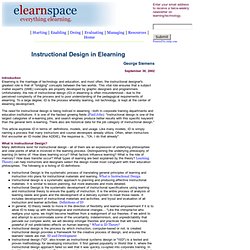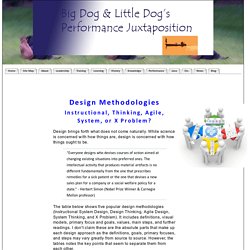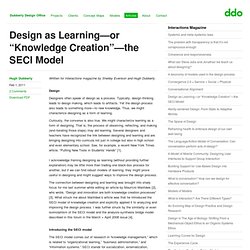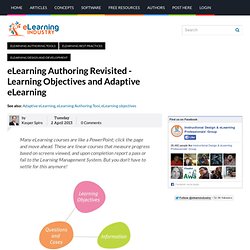

What Is Agile Learning Design? If you’re in the learning design business, then you’ve probably come across the term “Agile” recently.

You also might have heard terms that sound like a different language, like Kanban or Scrum. All this new terminology can get confusing, so that’s why we’re going to try and make sense of it. For almost 40 years the ADDIE model has reigned as king—the unquestionable framework for learning and development professionals. Now that has finally begun to change. Agile is a fresh approach to learning design that takes the ADDIE model to a new level. It All Started With a Problem Agile started as a software development process.
The problem is that this method is extremely impractical for software development. The Manifesto for Agile Software Development By the mid-90s, software developers had had enough, and they came up with their own ways of doing things. It defined the Agile development process as an iterative method based on collaboration. Instructional Design in Elearning. Instructional Design in Elearning George Siemens September 30, 2002 Introduction Elearning is the marriage of technology and education, and most often, the instructional designer's greatest role is that of "bridging" concepts between the two worlds.

This vital role ensures that a subject matter expert's (SME) concepts are properly developed by graphic designers and programmers. Unfortunately, the role of instructional design (ID) in elearning is often misunderstood - due to the perceived complexity of the process and to poor understanding of the pedagogical requirements of elearning. The need for instructional design is being noticed in elearning - both in corporate training departments and education institutions.
This article explores ID in terms of: definitions, models, and usage. 2007- La scénarisation pédago ds ts ses états. Design : 5 méthodes. Design brings forth what does not come naturally.

While science is concerned with how things are, design is concerned with how things ought to be. “Everyone designs who devises courses of action aimed at changing existing situations into preferred ones. The intellectual activity that produces material artifacts is no different fundamentally from the one that prescribes remedies for a sick patient or the one that devises a new sales plan for a company or a social welfare policy for a state.” - Herbert Simon (Nobel Prize Winner & Carnegie Mellon professor) The table below shows five popular design methodologies (Instructional System Design, Design Thinking, Agile Design, System Thinking, and X Problem). It includes definitions, visual models, primary focus and goals, values, main steps, and further readings. If you would like to discuss any of these design models, please leave a comment on my blog post.
10 sites de photos gratuites et libres de droits. Si les banques d’images permettent de payer pour utiliser telle ou telle photo, à des prix plus ou moins onéreux suivant la qualité et les droits associés, certaines proposent également un catalogue de photos libres de droits gratuites.

GraphismeTV : think & do. E-Learning and Instructional Design Resource. Magazine webdesign et blog collaboratif - Blog Du Webdesign. Le dessin est l’outil indispensable de la création, de l’aide à la décision, des grandes idées ! Hello Je lisais cette après-midi un article sur le dessin et le design et j’ai eu envie de vous partager la question suivante : Je suis designer depuis bientôt 9 ans et je n’ai jamais quitté mes carnets, mes crayons ni mon ordinateur.

Je dessine chaque jour (pour réfléchir, pour travailler, pour illustrer ou pour le plaisir du défi comme je l’ai fait pendant un an) et chaque jour j’apprends un peu plus. Pour moi, le dessin est tantôt: Design as Learning—or “Knowledge Creation”—the SECI Model. Written for Interactions magazine by Shelley Evenson and Hugh Dubberly.

Design Designers often speak of design as a process. Typically, design thinking leads to design making, which leads to artifacts. Yet the design process also leads to something more—to new knowledge. Thus, we might characterize designing as a form of learning. Curiously, the converse is also true. I acknowledge framing designing as learning (without providing further explanation) may be little more than trading one black-box process for another, but if we can find robust models of learning, they might prove useful in designing and might suggest ways to improve the design process. The connection between designing and learning was brought into sharp focus for me last summer while editing an article by Maurício Manhães [2], who wrote, “Design and innovation are both knowledge creation processes” [3].
Introducing the SECI model The process moves from tacit knowledge to explicit knowledge and back. Conclusion Download PDF. eLearning Authoring Revisited - Learning Objectives and Adaptive eLearning. Many eLearning courses are like a PowerPoint; click the page and move ahead.

These are linear courses that measure progress based on screens viewed, and upon completion report a pass or fail to the Learning Management System. But you don’t have to settle for this anymore! There are free authoring tools available that let you create better eLearning courses that take less time to complete, and assess on the learner’s mastery of the learning objectives.In this post, we will review how easygenerator, a cloud-based free authoring tool that is rapidly adopted by eLearning professionals, provides these design options and functionalities.Let’s explore how to design an eLearning course in easygenerator when learning objectives drive content presentation and course flow.
Designing the eLearning courseWhen designing an eLearning course, it is important to first determine learning objectives. More detailed info and examples are available on the easygenerator website: